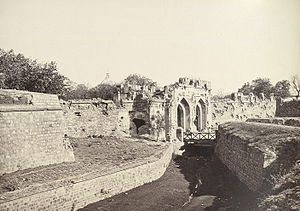Siege of Delhi
| Siege of Delhi | |||||||
|---|---|---|---|---|---|---|---|
| Part of the Indian rebellion of 1857 | |||||||
 Battle damage to the Cashmeri Gate in Delhi, 1857. |
|||||||
|
|||||||
| Belligerents | |||||||
|
Native irregulars Civilian volunteers |
Mughal Empire Indian Forces (sepoys and irregular mujahideen) |
||||||
| Commanders and leaders | |||||||
|
|
Bahadur Shah II Mirza Mughal Bakht Khan Maulana Sarfaraz Ali |
||||||
| Strength | |||||||
| 8,000 infantry 2,000 cavalry 2,200 Kashmiri irregulars 42 field guns 60 siege guns |
12,000 sepoys, approx. 30,000 irregulars, approx. 100 guns |
||||||
| Casualties and losses | |||||||
| 1,254 killed 4,493 wounded |
approx. 5,000 killed and wounded | ||||||
The Siege of Delhi was one of the decisive conflicts of the Indian rebellion of 1857.
The rebellion against the authority of the East India Company was widespread through much of Northern India, but essentially it was sparked by the mass uprising by the sepoys of the units of the Army which the company had itself raised in its Bengal Presidency (which actually covered a vast area from Assam to Peshawar). Seeking a symbol around which to rally, the first sepoys to rebel sought to reinstate the power of the Mughal Empire, which had ruled much of India during the previous centuries. Lacking overall direction, many who subsequently rebelled also flocked to Delhi.
This made the siege decisive for two reasons. Firstly, large numbers of rebels were committed to the defence of a single fixed point, perhaps to the detriment of their prospects elsewhere, and their defeat at Delhi was thus a very major military setback. Secondly, the British recapture of Delhi and the refusal of the aged Mughal Emperor Bahadur Shah II to continue the struggle, deprived the rebellion of much of its national character. Although the rebels still held large areas, there was little co-ordination between them and the British were inevitably able to overcome them separately.
After several years of increasing tension among the sepoys (Indian soldiers) of the British East India Company's Bengal Army, the sepoys at Meerut, 43 miles (69 km) northeast of Delhi, openly rebelled against their British officers. The flashpoint was the introduction of the Pattern 1853 Enfield rifle. The cartridges for this were widely believed to be greased with a mixture of cow and pig fat, and to bite them open when loading the rifle (as required by the drill books) would defile both Hindu and Muslim soldiers.
Eighty-five men of the 3rd Bengal Cavalry stationed at Meerut refused to accept their cartridges. They were hastily court martialled, and on 9 May 1857 they were sentenced to long periods of imprisonment and were paraded in irons before the British and Bengal regiments in the garrison. On the evening of the following day, soldiers of the Bengal regiments (3rd Light Cavalry, 11th and 20th Infantry) rebelled, releasing the imprisoned troopers and killing their British officers and many British civilians in their cantonment.
...
Wikipedia
